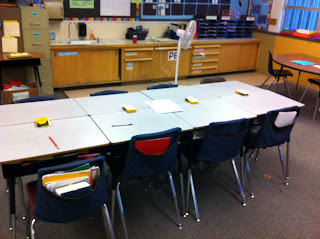WARNING: This is about to change your life....
I print the prompts on POST-IT NOTES! (See BELOW for instructions on how to print on Post-It Notes).
Printing on Post-Its has been awesome! While a little more time consuming that just writing a prompt on the board and requiring students to copy it down, the kids are really excited to pull a Post-It Prompt off the board in the morning and paste it down.
I also use my Journaling time as a self-starter first thing in the morning, so this process also makes it easy for me to see how many students have begun working and how many have not (based on how many Post-Its are left on the board). For example: "Wow! More than half the class has started their journals already. This is great!" and "Hmm. Are there two students absent today? Or have they just forgotten to grab their Prompt?"
During the first week of school, I review the Expectations for Daily Journaling with my class each day. I also printed miniature copies of this document for students to glue into the inside covers of their journals, next to their Journaling Rubrics. Journaling Expectations include:
- Copy the prompt into your journal (or stick the Post-It in!)
- Start Writing. Your entry should end up being at least five sentences.
- Use 7-UP Sentences: at least seven words per sentence.
- Be prepared to share your response if you are called upon.
CLICK HERE to download the Daily Journaling Expectations.
I have also created a Journaling Rubric, which I laminated and attached to the inside covers of each student journal. Students turn in their journals about once a month to be graded.
CLICK HERE to download the Journaling Rubric.
HOW TO PRINT ON POST-IT NOTES:
- Print out the Sticky Note Template on a piece of cardstock.
- Once printed, line up six 3x3 Post-It Notes in the boxes. Make sure you know the direction your Post-Its need to be lined up to fit into your printer.
- Place your blank sticky notes (on the cardstock) into your printer. You'll want the sticky side to go in first in order to avoid paper jams.
- Open up the Prompt that you want to use and print!
- After printing and removing your Post-Its, cut them in half. Each page will produce a total of 12 prompts.
CLICK HERE to download a Sticky Note Template.
And finally, out of the goodness of my heart....CLICK HERE for 50+ prompts formatted for your Sticky Note Template.










































